Material Matters
The Quarterly Magazine of NIST's Material Measurement Laboratory
Spring 2017
Measurement Science for Infrastructure Renewal
In this issue
- A Message from the MML Director
- Move Over, Superman! NIST 'Spectral Fingerprinting' Sees Through Concrete to Detect Early Corrosion
- Silk Sensor Could Speed Development of New Infrastructure, Aerospace and Consumer Materials
- NIST Quest for Climate-Friendly Refrigerants Finds Complicated Choices
- Precipitation Kinetics and Development Pathway of the Most Widely Used Aircraft Alloy
- Better Nanoimages 'Spin' The Path to Improved Magnetic Memory
- NIST Patents First DNA Method to Authenticate Mouse Cell Lines
- Graphene Lid Revitalizes Imaging Technique
- ‘Start Codons’ in DNA and RNA May Be More Numerous Than Previously Thought
- NIST Technology Used to Help Identify Key Enzymes in Disease
- Popular Proteomics Tool Now Incorporates NIST Mass Spectral Search Software
- Outreach and Partnering
- Recent Awards
A Message from the MML Director

Director*
Material Measurement Laboratory
NIST
According to the American Society of Civil Engineers, nearly ten percent America’s bridges are structurally deficient or functionally obsolete, one-fifth of our highway pavement is in poor condition, and over two trillion gallons of treated drinking water is wasted each year from an estimated 240,000 water main breaks. In short, our nation’s physical infrastructure is in bad shape, and in dire need of attention.
A healthy physical infrastructure is essential for maintaining our physical security, preserving our quality of life, and helping our economy thrive. At NIST’s Material Measurement Lab (MML), we are working to make a safe and healthy infrastructure a reality. From providing quality assurance standards that cement and steel manufacturers can rely upon to providing accurate assessment tools for pipeline manufacturers and water treatment, our work enables a better, more reliable infrastructure network.
With so much of our infrastructure in need of attention, MML research also gives decisionmakers the intelligence they need to prioritize our nation’s many infrastructure projects. Our work helps ensure the accuracy of steel hardness measurements, which are used to
check the strength of steel alloys that may be used in infrastructure projects. We measure impact energy, which helps to predict when structures are in need of replacement or repair (before catastrophic failure). We also calibrate the equipment that can measure flaws and weaknesses in existing infrastructure without damaging it or taking it out of service.
To ensure we continue to innovate and lead physical infrastructure measurement, we have renewed our dedication to infrastructure research by making it part of the MML Strategic Plan. Our plan directs our materials and chemical scientists and engineers to develop new materials models that fully account for the ongoing reduction in structural capacity in infrastructure components and systems. Such models promise to guide the development of new infrastructure materials resulting in more effective, lower cost solutions.
In this issue of Material Matters, you can read about some of our latest infrastructure research, including advanced corrosion detection, an embedded, nanoscale composite damage sensor, and our ongoing project to improve pipeline materials, in addition to research across the other areas of MML’s research portfolio.
Part of NIST’s mission is to improve quality of life, and little is more central to the quality of our lives than the infrastructure in which we live. Though much needs to be done, at MML we have the right tools to put words into action.
* During the transition to a new presidential administration, Laurie Locascio, MML director, is serving as NIST’s acting associate director for laboratory programs. Michael Fasolka, long-time MML deputy director, is acting director of MML.
Move Over, Superman! NIST 'Spectral Fingerprinting' Sees Through Concrete to Detect Early Corrosion
April 26, 2017
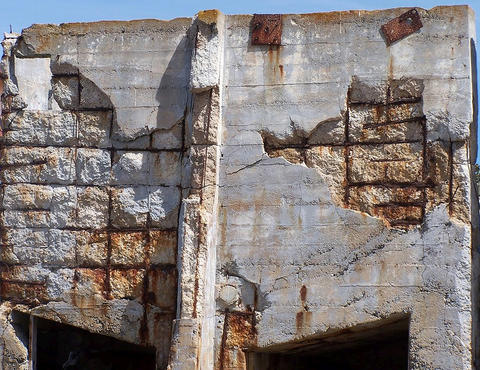
When you suffer a fall, an on-the-field collision or some other traumatic blow, the first thing the doctor will do is take an X-ray, CT scan or MRI to determine if anything has been damaged internally. Researchers at the National Institute of Standards and Technology (NIST) are using the same principle, but in a more powerful form, to detect corrosion, the primary danger threatening the health of the steel framework within the nation’s bridges, roads and other aging physical infrastructure.
What they have developed is a noninvasive “spectral fingerprint” technique that reveals the corrosion of concrete-encased steel before it can cause any significant degradation of the structure it supports. The detection method is described in a new paper in the journal Applied Magnetic Resonance.
When water and oxygen corrode iron, different iron oxide products are produced, with the two most common being goethite and hematite. “The brown rust that forms when you leave a hammer out in the rain is mostly goethite, and when a steel reinforcing bar [rebar] corrodes inside a concrete bridge deck, that is mostly hematite,” said NIST physical chemist Dave Plusquellic. “We have shown in our new study with goethite, and our previous work
Silk Sensor Could Speed Development of New Infrastructure, Aerospace and Consumer Materials
March 17, 2017
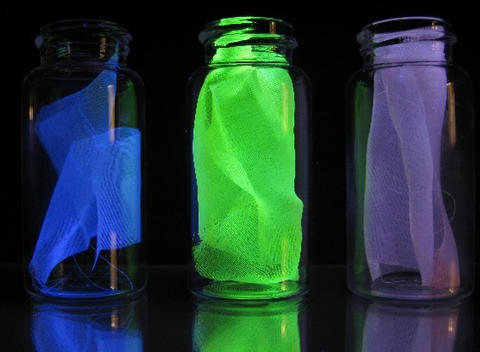
Consumers want fuel-efficient vehicles and high-performance sporting goods, municipalities want weather-resistant bridges, and manufacturers want more efficient ways to make reliable cars and aircraft. What’s needed are new lightweight, energy-saving composites that won’t crack or break even after prolonged exposure to environmental or structural stress. To help make that possible, researchers working at the National Institute of Standards and Technology (NIST) have developed a way to embed a nanoscale damage-sensing probe into a lightweight composite made of epoxy and silk.
The probe, known as a mechanophore, could speed up product testing and potentially reduce the amount of time and materials needed for the development of many kinds of new composites.
The NIST team created their probe from a dye known as rhodamine spirolactam (RS), which changes from a dark state to a light state in reaction to an applied force. In this experiment, the molecule was attached to silk fibers contained inside an epoxy-based composite. As more and more force was applied to the composite, the stress and strain activated the RS, causing it to fluoresce when excited with a laser. Although the change was not visible to the naked eye, a red laser and a microscope built and designed
NIST Quest for Climate-Friendly Refrigerants Finds Complicated Choices
February 17, 2017

BOULDER, Colo. – Researchers at the National Institute of Standards and Technology (NIST) have just completed a multiyear study to identify the “best” candidates for future use as air conditioning refrigerants that will have the lowest impact on the climate.
Unfortunately, all 27 fluids NIST identified as the best from a performance viewpoint are at least slightly flammable, which is not allowed under U.S. safety codes for most end uses. Several fluids among the list of refrigerants are highly flammable, including propane, the fuel for outdoor grills.
In other words, the NIST study found no ideal refrigerant that combined low “global warming potential” (GWP)—a measure of how much heat a gas will trap if released into the atmosphere— with other desirable performance and safety features such as being both nonflammable and nontoxic. The results appear in Nature Communications.
“The takeaway is there is no perfect, easy replacement for current refrigerants,” NIST chemical engineer Mark McLinden said. “Going into the study, we thought surely there has to be something else. Turns out, not so much. So it was a bit surprising, a bit disappointing.”
To help reduce global warming, nearly 200 nations, including the United States, in October 2016 agreed to
Precipitation Kinetics and Development Pathway of the Most Widely Used Aircraft Alloy

The U.S. aluminum industry is estimated to have generated more than $75 billion a year in direct economic impact in 2016. Aluminum alloy 2024 (AA2024), which makes use of copper as the main alloying element and features a good combination of yield strength and toughness, is the most widely used aircraft alloy. Its strengthening mechanism is precipitation hardening, achieved through heat treatment. Despite its obvious commercial importance, a comprehensive understanding of the in situ evolution of the precipitate structure and morphology of AA2024 during heat treatment is still lacking, mostly due to the sub-angstrom to micrometer size range that must be characterized.
Under a partner-user agreement between NIST and the Advanced Photon Source at the Argonne National Laboratory, NIST researchers have recently developed a synchrotron-based scattering methodology that enables across-length-scale characterization of structural and microstructural transformation in a wide range of engineering and functional materials. The researchers employed this methodology to examine the nucleation and growth of the hardening precipitates in AA2024, and determine the corresponding kinetic time scales and activation energies. These behaviors are critical to understanding the hardening of the alloy, which is achieved by impeding the movement of dislocations with precipitates. An improved understanding of the precipitation kinetics, together with their atomic structure and microstructure, can serve to establish the structure–performance relationships in alloys, and lead to a more rational design of alloys for specific applications.
Zhang, F., Levine, L. E., Allen, A. J., Campbell, C. E., Creuziger, A. A., Kazantseva, N., Ilavsky, J., In Situ Structural Characterization of Ageing Kinetics in Aluminum Alloy 2024 across Angstrom-to-Micrometer Length Scales, ACTA Materialia 111, 2016, https://doi.org/10.1016/j.actamat.2016.03.058
Better Nanoimages 'Spin' The Path to Improved Magnetic Memory
March 16, 2017
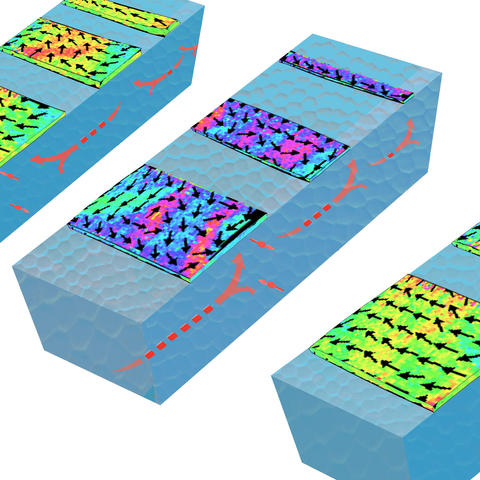
In work that could help make possible a faster, longer-lasting and lower-energy method of data storage for consumers and businesses, researchers at the National Institute of Standards and Technology (NIST) and their colleagues have developed a technique for imaging and studying a promising class of magnetic devices with 10 times more detail than optical microscopes.
Magnetic materials have attracted a growing number of researchers in the quest to more rapidly store and read bits of digital information. In a magnetic system, data is encoded by the direction of the magnetization: A bar magnet with its north pole pointing up can represent the binary code “0,” while the same magnet with its north pole pointing down can represent a “1.” Unlike the standard semiconductor computer chip, magnetic memory devices can retain information even if the power is turned off.
By controlling when and how quickly the magnetization can be flipped without expending significant electrical power, scientists hope to improve an existing technology called Magnetic Random Access Memory, or MRAM, into a leading tool for reading, writing and storing information. MRAM is not yet competitive with other existing methods of data storage such as flash RAM, but offers advantages over present-day technologies
NIST Patents First DNA Method to Authenticate Mouse Cell Lines
February 23, 2017
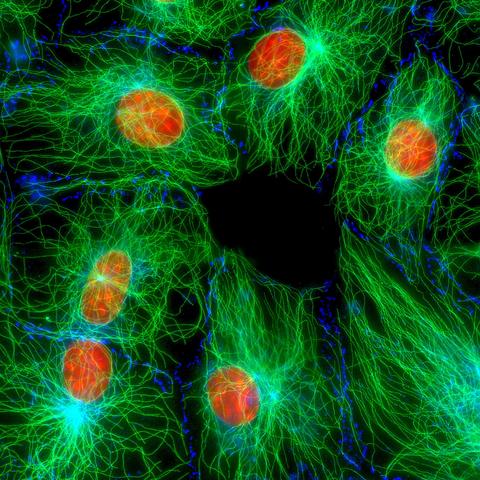
“A case of mistaken identity” may drive the plot of the latest spy film or crime novel, but it’s only a tale of trouble for geneticists, oncologists, drug manufacturers and others working with mouse cell lines, one of the most commonly used laboratory model systems for genetic research. Cell lines that have been contaminated or misidentified due to poor laboratory technique and human error lead to inaccurate research studies, retracted publications and wasted resources. In fact, many scientific funding organizations, such as the National Institutes of Health, now require scientists to verify their cell lines for identity and quality before research grants are awarded.
To help address this challenge, the National Institute of Standards and Technology (NIST) is working with partners to design tools, establish datasets, and further develop and standardize NIST’s system to authenticate mouse cell lines. One of the first milestones in this effort is the recently granted U.S. patent (No. 9,556,482) for an authentication method using NIST-identified short tandem repeat (STR) markers — tiny repeating segments of DNA found between genes — for mouse cell lines. The method
Graphene Lid Revitalizes Imaging Technique
March 31, 2017
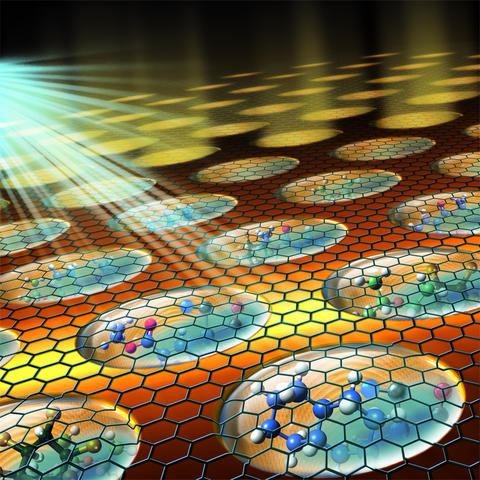
By capping liquids with graphene, an ultrathin sheet of pure carbon, researchers at the National Institute of Standards and Technology (NIST) and their colleagues have revitalized and extended a powerful technique to image surfaces. The graphene lids enable researchers for the first time to easily and inexpensively image and analyze liquid interfaces and the surface of nanometer-scale objects immersed in liquids. The new capability has the potential to advance the development of batteries, highly charged capacitors for power-grid technology, and new catalysts such as those used in the chemical industry.
In the imaging technique, known as photoemission electron microscopy (PEEM), ultraviolet light or X-rays bombard a sample, stimulating the material to release electrons from a region at or just beneath its surface. Electric fields act as lenses, focusing the emitted electrons to create an image.
Researchers have used the method for decades to discern such fine-scale features as the patterns of chemical reactions on the surface of catalysts, as well as the magnetic field structure of memory devices and the molecular architecture of biological compounds. But PEEM has typically been restricted to solid surfaces that are in a high-vacuum environment. The method hasn’t had the ability to study liquids and
‘Start Codons’ in DNA and RNA May Be More Numerous Than Previously Thought
February 21, 2017
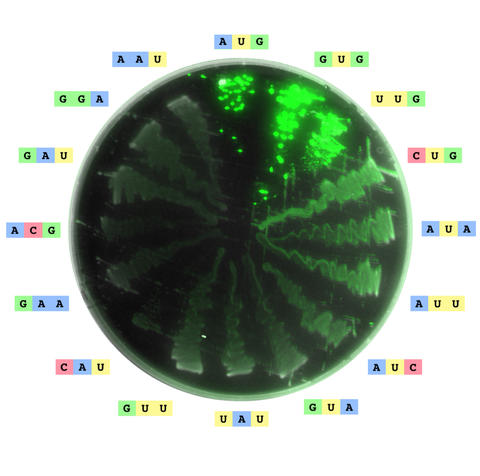
For decades, scientists working with genetic material have labored with a few basic rules in mind. To start, DNA is transcribed into messenger RNA (mRNA), and mRNA is translated into proteins, which are essential for almost all biological functions. A central principle regarding translation has long held that only a small number of three-letter sequences in mRNA, known as start codons, could trigger the production of proteins. But researchers might need to revisit and possibly rewrite this rule, after recent measurements from a team including scientists from the National Institute of Standards and Technology (NIST).
The findings, to be published on February 21, 2017, in the journal Nucleic Acids Research by scientists in a research collaboration between NIST and Stanford University, demonstrate that there are at least 47 possible start codons, each of which can instruct a cell to begin protein synthesis. It was previously thought that only seven of the 64 possible triplet codons trigger protein synthesis.
“It could be that many potential start codons had remained undiscovered because no one could see them,” said lead author Ariel Hecht, a team member at the Joint Initiative for Metrology in Biology (JIMB), a research collaboration that includes NIST and Stanford.
Scientists
NIST Technology Used to Help Identify Key Enzymes in Disease
Elephantiasis and river blindness are neglected tropical diseases caused by filarial nematode parasites that are transmitted to humans by insects. Collectively, they afflict 150 million people in over 80 countries and threaten the health of over 1.5 billion. MML scientists recently contributed to a paper in the journal Nature Communications that reports the discovery of a series of cyclic peptides and analogues that exhibit potent and isozyme-selective inhibition against enzymes essential for the parasites that cause elephantiasis and river blindness, but that are absent from humans. There are no high-throughput screening methods that can directly measure the activity of these key enzymes (phosphoglycerate mutases). So, the conventional approach uses two additional coupling enzymes to produce a color change in the inhibition screening assay. This can lead to problems if the apparent inhibition is due to a reaction of the drug molecule with the coupling enzymes instead of the targeted mutase enzyme. The NIH National Center for Advancing Translational Science (NCATS) approached NIST about the possibility of applying NIST technology to this problem. To verify the NCATS results, NIST scientists developed a method, based on gradient elution moving boundary electrophoresis, that directly measures the activity of the mutase enzymes.
The cyclic peptides and accompanying crystallographic information described in the paper reveal an important binding mode and inhibition mechanism for an enzyme previously considered ‘undruggable’ and may be applicable to other difficult drug targets.
Popular Proteomics Tool Now Incorporates NIST Mass Spectral Search Software
The newest release of Mascot, a popular proteomics software package, incorporates the peptide library search program MSPepSearch developed by the NIST Mass Spectrometry Data Center. Mass spectrometry is the most widely used discovery tool in proteomics and identification of proteins/peptides in a sample is the key first step. Mascot, maintained by Matrix Science Ltd, aims at determination of the precise identities of as many proteins/peptides as possible in each biological sample mass spectral data set. Prior versions of Mascot used simple theoretical fragmentation models of the peptide for identification. In the new release of Mascot, NIST’s MSPepSearch is incorporated to allow a faster, more reliable method for identifying peptides by matching them to spectra in a mass spectral library. This method also enables spectra for unusual and unpredictable spectra to be identified in the same way as conventional peptides. NIST has been a leader in developing spectral libraries for many years, including extensive libraries of peptides.
Outreach and Partnering
Launch of the High-Throughput Experimental Materials Virtual Laboratory
NIST and the National Renewable Energy Laboratory (NREL) have launched the High-Throughput Experimental Materials Virtual Laboratory (HTE-MVL), with the goal of generating the huge volumes of data needed to validate existing materials models and develop new, more sophisticated ones. The HTE-MVL will consist of a national network of high-throughput synthesis and characterization tools integrated into the Materials Genome Initiative materials data infrastructure. The facility will foster coordination and data integration across high-throughput experimental programs. The result will be a widely accessible, growing resource open to the entire materials research community.
The primary goal of the MGI is the discovery, optimization, and commercial deployment of novel materials twice as fast as today’s practice, and at reduced cost. Since its inception in 2011, the MGI has resulted in significant progress in computational simulation and modeling to enable predictions of materials properties. More recently, an experimental component, based on high-throughput experimental materials science, has been added. However, there remain serious challenges that the materials community must overcome to enable widespread deployment of an MGI-type approach to novel materials development. For example, data, both experimental and simulated, must be made discoverable, accessible, and interoperable. Further, even one “brick and mortar” high-throughput experimental facility would be very costly. The HTE-MVL was established in response to both challenges.
To promote the success of this project NIST and NREL are working on several fronts:
- Development of a conceptual model for integration of components within the materials data infrastructure consisting of: registries, repositories, data transfer services, laboratory information management systems, instruments, computing, etc.
- Development of a specialized registry and repository to enable discovery and access of items within the virtual laboratory, such as sample libraries, instruments, data, etc.
- Development of community interchange standards for data and metadata
- Execution of a round-robin experiment where transparent conducting oxide libraries are synthesized and characterized by both institutions and data is managed by the new materials data infrastructure.
- Outreach to critical stakeholders, such as funding agencies, potential new member institutes, potential new users, potential new contributors, and potential new data consumers.
Green, M. L., Choi, C. L., Hattrick-Simpers, J. R., Joshi, A. M., Takeuchi, I., Barron, S. C., Campo, E., Chiang, T., Empedocles, S., Gregoire, J. M., Kusne, A. G., Martin, J., Mehta, A., Persson, K., Trautt, Z., Van Duren, J., and Zakutayev, A., “Fulfilling the promise of the materials genome initiative with high-throughput experimental methodologies,” Applied Physics Reviews 4, 2017, https://dx.doi.org/10.1063/1.4977487
Federal Material Science Leaders Gather at NIST
“How can federal scientists across agencies most effectively address pressing national needs?” Over 100 federal scientists convened at the Federal Interagency Materials Representatives meeting, held at the NIST Gaithersburg campus on February 1, 2017 to address this question. Participants included federal scientists from the U.S. Depts. of Commerce, Defense, Energy, and Transportation, NASA, the National Science Foundation, and more. Plenary speakers, including Linda Horton from Dept. of Energy, Basic Energy Sciences, Benjamin Leever from the Air Force Research Laboratory, and Heather Evans from NIST shared best practices and lessons learned for planning and managing government agency investments in science, engineering, and technology to enhance the impact of materials research in the U.S. Scientists discussed successes and challenges in strategic planning, coordination, research overlap, the connection between basic and applied research, and leveraging center- and institute-based research structures during breakout sessions. The annual meeting is open to federal scientists.
Collaboration to Understand Armor Backing Material Rheology
Behind-armor blunt trauma is a deformation in the ballistic witness material caused when armor stops a projectile from perforating armor. Understanding the rheological behavior of this material is critical for the future of both Department of Defense and civilian documentary standards that rely on ballistic witness materials for determination of compliance with requirements for behind-armor blunt trauma protection. Recently, members of MML’s Security Technologies Group hosted representatives from the Army Research Laboratory (ARL) in Aberdeen, Maryland and Aberdeen Test Center (ATC) to discuss rheological characterization of a potential new ballistic witness material being formulated by ARL and ATC designated as ARTIC. NIST will use new specialized technology to characterize the rheological properties of several candidate formulations of ARTIC.
Regenerative Medicine Standards Coordinating Body
More and larger companies are entering the regenerative medicine field through the development of cell therapies such as CAR-T. Standards play an important role in helping to assure the quality of regenerative medicine products and processes, and speed regulatory approval. The Standards Coordinating Body (SCB) is an industry-led public-private partnership with NIST to help coordinate standards development for regenerative medicine. Coordination is key considering the passage of the 21st Century Cures Act, which directs the U.S. Secretary of Health and Human Services to confer with NIST and other stakeholders to facilitate the coordination and prioritization of the development of standards for regenerative medicine. MML representatives recently met with representatives of the SCB to discuss priorities for carrying out the intentions of the agreement. The partnership with the SCB will be important as NIST determines how best to prioritize activities in this rapidly evolving field.
NIST/IBM Collaborative Study on Self-Assembled Structure Published
The journal Macromolecules recently published a paper by MML researcher Vivek Prabhu, with a colleague from the IBM Almaden Research Center, on block co-polymer self-assembled structure. The paper shows, through very detailed experiments, that the chemical nature of the end-group of a block co-polymer can strongly affect the microstructure of a self-assembled structure. Block copolymers are like surfactants in that one part of the molecule is different than the other (i.e. ‘likes’ oil or ‘likes’ water). These copolymers self-assemble into a variety of structures that are used in drug delivery, food products, or as microgels. The structure determines the properties such as the rate of a drug delivery. Here, the chemical nature of just the end group, a small part by mass, is strong enough to lead to many structural changes that are probed in detail.
Recent Awards
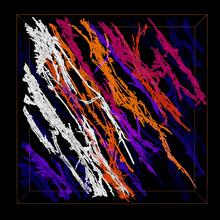
Natarajan Wins FEI Image Award
Bharath Natarajan, a NIST associate from Georgetown University working on the 3-D imaging of carbon and cellulose nanofibers in the Nanomanufacturing Program, submitted an image of a 3-D volume reconstruction of a forest of carbon nanotubes (CNT) embedded in epoxy, titled “A (CNT) bundle is strong.” The transmission electron microscopy (TEM) sample was prepared by focusing ion beam (FIB) milling in a FEI Helios FIB and imaged in an FEI Titan TEM using electron tomography. The tilt series was reconstructed and then processed using in-house software to identify CNT bundles and color them based on their size. This bundling information is key to understanding the network properties as well the axial mechanical properties of these composites.

Glover Receives ASTM Award
Jack Glover, of MML’s Security Technologies Group, has received an ASTM F12 Award of Excellence in recognition of his efforts and accomplishments in developing the recent significant revision of the ASTM F792 “Standard Practice for Evaluating the Imaging Performance of X-ray Systems.” This revision included the design, development, and performance verification of the image quality artifact standards and of the algorithms used to compute the image quality parameter values. ASTM F792 is the major technical performance standard for testing cabinet X-ray systems, such as those used to screen carry-on baggage at airports. The standard was first published in 1982 and is used throughout the world for testing cabinet X-ray systems. For the first time in 15 years, the standard recently underwent a major revision. The working group, led by NIST researchers Jack Glover, Ron Tosh, Larry Hudson, and Nick Paulter, also included representatives from the governments of Germany, UK, Brazil, and Australia as well as U.S. agencies such as the Department of Homeland Security, Transportation Security Administration, and Federal Bureau of Prisons and numerous equipment manufacturers. This revision of the standard was a major improvement and was necessary to keep pace with the evolving technology at the checkpoint. The F12 Award of Excellence was established in 1997 and is conferred, as warranted, by Committee F12 on Security Systems and Equipment in recognition of meritorious contributions to the cause of voluntary standardization, specifically with respect to security systems and equipment standards. The award has been established to recognize outstanding service to Committee F12.

NIST Guest Researcher Honored with Lithuania National Science Prize
On March 7, 2017, Gintaras Valinčius, division chief at the Biochemical Institute of Vilnius University and NIST guest researcher, was awarded the Lithuania National Science Prize. Valinčius was recognized for his indefatigable commitment to research/science development in Lithuania and the European Union, teaching at Vilnius University, and his seminal contributions to electrochemistry and electrochemical impedance to spectroscopy (EIS) in particular. The National Science Prize is one of the top prizes awarded to scientists in Lithuania and has been called ‘Lithuania’s Nobel Prize.’ Valinčius has a long history of collaborative research with NIST and the Institute of Bioscience and Biotechnology Research. Valinčius first came to NIST as a visiting scientist in 1998 and has returned nearly every year to conduct research focused on hybrid bilayer membrane and tethered bilayer lipid membranes. Using tether compounds synthetically prepared by retired NIST employee, Dave Vanderah, Valinčius carried out careful EIS measurements demonstrating the preparation of highly insulating lipid bilayers, essential for the study of integral membrane proteins, which comprise 60% of all drug targets by the pharmaceutical industry. Together they have co-authored 14 papers since 2003. Over the last three years, Valinčius has developed the first theoretical framework that allows EIS spectral data to be interpreted in more realistic structural models rather than the less informative resistance-capacitance circuit models.

Coble Elected Fellow of the American Academy of Forensic Science
Mike Coble of MML’s Applied Genetics Group was recently elected Fellow of the American Academy of Forensic Science (AAFS) at their 2017 annual meeting. AAFS is a multi-disciplinary professional organization that provides leadership to advance science and its application to the legal system. The objectives of the Academy are to promote professionalism, integrity, competency, and education, and foster research, improve practice, and encourage collaboration in the forensic sciences. Over the past 16 years, Coble has been an active member in AAFS, presenting his work on DNA mixture analysis, and acting as moderator, student presentation judge, and workshop leader. The leadership of AAFS recognized these contributions and Coble’s substantial contributions to the forensic science literature and training regarding DNA mixture analysis with the honor of Fellow.
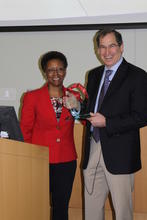
Tarlov Delivers Memorial Lecture at UMD School of Pharmacy Annual Research Day
On April 12, 2017, MML Division Chief Michael Tarlov gave the Andrew G. DuMez Memorial Lecture at the University of Maryland School of Pharmacy in Baltimore, held during their annual research day. Tarlov’s talk was entitled “The Role of Measurements and Standards in the Development and Manufacturing of Biopharmaceuticals.” After the talk, Natalie Eddington, Dean of the UMD School of Pharmacy, presented Tarlov with an honorary award.
Best Paper Award from the Microscopy Society of America
The Microscopy Society of America recently recognized a NIST/University of Arizona authored paper (led by MML’s Vladimir Oleshko) as the best paper in the Materials Applications category. The paper is entitled, “Analytical Multimode Scanning and Transmission Electron Imaging and Tomography of Multiscale Structural Architectures of Sulfur Copolymer-Based Composite Cathodes for Next Generation High-Energy Density Li-S Batteries.” Microscopy and Microanalysis is an international microscopy journal published for the Microscopy Society of America (MSA) by Cambridge University Press. It is the official journal of the Microscopy Society of America, Microanalysis Society, and several other societies. Each year the journal selects the best paper in three different categories: Materials Applications, Biological Applications, and Techniques and Equipment Development. The award will be presented to Oleshko at the Microscopy and Microanalysis 2017 Meeting by Ian Anderson, President of MSA.

